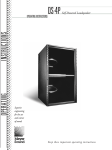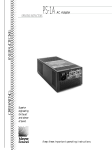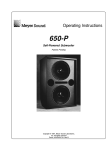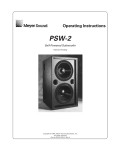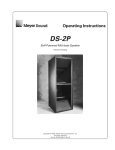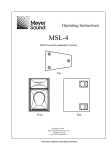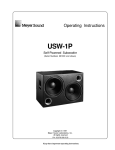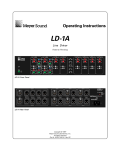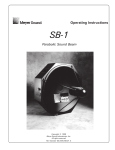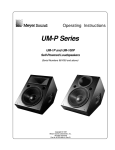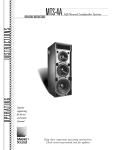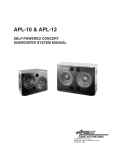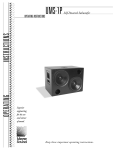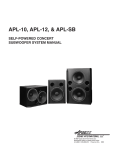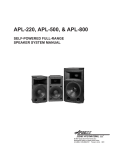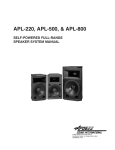Download Meyer Sound PSM-2 Operating instructions
Transcript
PSM-2 Operating Instructions Patents Pending Self-Powered Stage Monitor PSM-2 at 55° PSM-2 at 35 ° The PSM-2 self-powered stage monitor contains independent amplifier and control electronics for one 12” cone driver and one 4” diaphragm horn driver in a compact enclosure. This integrated design eliminates amplifier racks, improves durability and reliability, and simplifies setup and installation. varying speaker impedance by measuring current, in addition to voltage, to compute the power dissipation and voice coil temperature. The PSM-2 can be oriented such that the planes of the cabinet face and the horizontal surface on which the PSM-2 is placed form a 35°, 55°, or 90° angle. Its top-tobottom profile is 20.5” at 35°, and 19.5” at 55° (1” higher than the Meyer UM-1). The high-Q horn provides uniform coverage in both the horizontal and vertical planes. The PSM-2 has the following acoustical specifications: Frequency Response ± 4 dB 50 Hz – 18 kHz Max Peak SPL at 1 m 139 dB Dynamic Range > 110 dB Coverage –6 dB: 50° H x 50° V –10 dB: 70° H x 70° V The PSM-2 is phase-corrected through the crossover and has an overall phase response of ±90° 200 Hz–16 kHz, which yields exceptional system impulse response and accurate reproduction of all signals. The PSM-2 employs TruPower™ limiting (TPL), the first limiting technique that accurately calculates the power dissipation within the speaker. TPL accounts for All Meyer self-powered speakers use TPL, which • allows the speaker to produce its highest SPL across its entire frequency range during limiting; • eliminates long-term power compression when the loudspeaker is operated at high levels for extended periods; • protects the drivers and extends the lifetime of amplifier and driver components. The PSM-2 uses the Intelligent AC™ power supply, which protects the amplifier and drivers by autoselecting the voltage, minimizing inrush current, filtering EMI, and performing surge suppression. The dualchannel amplifier (620 W/channel) is cooled by a variablespeed primary fan that runs continuously, and a secondary fan that turns on when the PSM-2 is operated in hot conditions or at its maximum level for an extended period. The PSM-2 can be equipped to operate with the Remote Monitoring System™ (RMS) interface network and software application. RMS displays signal and power levels, driver and cooling fan status, limiter activity, and amplifier temperature for all speakers in the network on a Windows-based PC. Symbols Used These symbols indicate important safety or operating features in this booklet and on the chassis. ! Dangerous voltages: risk of electric shock Important operating instructions Frame or chassis Protective earth ground Pour indiquer les risques résultant de tensions dangereuses Pour indequer important instructions Masse, châssis Terre de protection Zu die gefahren von gefährliche spanning zeigen Zu wichtige betriebsanweisung und unterhaltsanweisung zeigen Rahmen oder chassis Die schutzerde Para indicar azares provengo de peligroso voltajes Para indicar importante funcionar y mantenimiento instrucciones Armadura o chassis Tierra proteccionista Declaration of Conformity According to ISO/IEC Guide and EN 45014 The Manufacturer: declares that the product: Product Name: PSM-2 Product Options: All Name: Meyer Sound Laboratories Address: 2832 San Pablo Avenue Berkeley, California 94702-2204, USA conforms to the following Product Specifications: Safety: EMC: EN 60065: 1994 EN 55022: 1987 IEC 801-2: 1984 IEC 801-3: 1984 IEC 801-4: 1984 - Class A 8 kV 3 V/m 0.5 kV Signal Lines, 1.0 kV Power Lines The product herewith complies with the requirements of the Low Voltage Directive 73/23/EEC and the EMC Directive 89/336/EEC. Office of Quality Manager Berkeley, California USA October 1, 1995 Environmental Specifications for Meyer Sound Electronics Products Operating temperature: 0° C to +45° C Non-operating temp: < –40° C or > +75° C Humidity: to 95% at 35°C Operating altitude: to 4600 m (15,000 ft) Nonoperating altitude: Shock: to 6300 m (25,000 ft) 30 g 11 msec half-sine on each of 6 sides 10 – 55 Hz (0.010 m peak-to-peak excursion) Vibration: Made by Meyer Sound, Berkeley, CA, USA U ® L UL LISTED 3K59 C ® COMMERCIAL AUDIO SYSTEM European Office: Meyer Sound Germany GmbH Carl Zeiss Strasse 13 56751 Polch, Germany Contact Information Meyer Sound Laboratories, Inc. 2832 San Pablo Avenue Berkeley, California 94702 Telephone: 510 - 486 - 1166 FAX: 510 - 486 - 8356 E-mail: [email protected] http://www.meyersound.com 2 Meyer Sound Germany Gmbh Carl Zeiss Strasse 13 56751 Polch, Germany Telephone: 49.2654.9600.58 FAX: 49.2654.9600.59 Contents Controls and Connectors .................................. Dimensions ........................................................ AC Power ........................................................... Audio Input ........................................................ Limiting and Protection Circuitry ..................... Example Applications ....................................... 7 Verifying Polarity ............................................... 8 Safety Summary ................................................ 9 Specifications .................................................. 10 3 3 4 5 6 Controls and Connectors ! WARNINGS: THIS PRODUCT MUST BE GROUNDED This surface may reach high temperatures while in use. To ensure proper operation, allow at least 6 inches clearance from this surface and adequate ventilation. To reduce the risk of electric shock do not remove cover. No operator serviceable parts inside. Refer servicing to qualified personnel. To reduce the risk of fire or electric shock do not expose this appliance to rain or moisture. Mains circuit breakers -I T IRK UK WARNING : THIS APPARATUS MUST BE EARTHED. NO OPERATOR SERVICEABLE PARTS INSIDE. REFER SERVICING TO QUALIFIED PERSONNEL PUSH 2+ 10K Ω ENTRETIEN ET REPARATIONS INTERNES NE SONT AUTORISEES QU'AU PERSONNEL TECHNIQUE QUALIFIÉ -I T RE Input Polarity Power LED (green/red) ATTENTION : S PU H -C Active / Speaker Fault Auto-Voltage Select 95-125V 208-235V 50-60Hz 50-60Hz 1400W RMS MAX 1400W RMS MAX 3+ ~ Balanced ~ -C 1 ESD 220K Ω Case Signal input and loop connectors 2 3 1 1 3 es ity ct Network A R iv et e ic k in W rv Se Remote Monitoring -C System ATTENTION : ENTRETIEN ET INTERNES NE SONT AUTORIU S PU H RE Remote Monitoring System panel (if RMS is installed) Loop ACHTUNG : GEHÄUSE NICHT UND REPARATUR NUR DURCH IRK 2 Earth / Chassis Input ATENCIÓN : ACCESO INTER AUTORIZADO A PERSONAL TÉ S PU H RE Input polarity switch This surface may reach high t To ensure proper operation, allow clearance from this surface and ad To reduce the risk of electric shoc No operator serviceable parts insi Refer servicing to qualified person To reduce the risk of fire or electr do not expose this appliance to ra ACHTUNG : GEHÄUSE NICHT ÖFFNEN WARTUNG UND REPARATUR NUR DURCH ELEKTROFACHKRÄFTE IRK HI Limit LO Limit ! WARNINGS: THIS PRODUCT M -I T RE -C High Limit (red) Low Limit (red) Tie-wrap anchor ATENCIÓN : ACCESO INTERNO SOLO AUTORIZADO A PERSONAL TÉCNICO CALIFICADO S PU H Meyer Sound, Berkeley, CA. USA PERSONNEL TECHNIQUE QUA -I T PSM-2 Mains AC inlet IRK UK WARNING : THIS APPAR NO OPERATOR SERVICEABLE PA REFER SERVICING TO QUALIFIED PUSH Auto-Voltage Select 5 10A RMS 1 20A Peak 2 88-127V 5 50-60Hz 700W RMS MAX 7 ~ 2 3 1 1 3 et ic es k A R rv in W Se Input ~ ~ 2 e Rear User Panel shown with the optional Remote Monitoring System (RMS) panel Operational voltage Turn on 80V Tur Tur Turn on 160V ct iv ity Network Loop Remote Monitor System Meyer Sound, Be European User Panel with IEC 309 connector Dimensions All units in inches Front Side Top 6.2 12.1 35° 55° 18.0 18.0 12.1 24.0 24.0 14.7 Grill shown here is 1.5" thick 3 Power Requirements AC Power The AC voltage operating ranges for the PSM-2 are 85–134 V and 165–264 V, at 50 or 60 Hz. The PSM-2 performs surge suppression for high voltage transients and can safely withstand voltages up to 275 VAC. Continuous voltages above 275 VAC may damage the unit! When an AC source is applied to the PSM-2, the Intelligent AC power supply • auto-selects the voltage; • performs surge suppression and minimizes inrush current; • filters EMI. After three seconds, the main power supply is slowly ramped on. The PSM-2 uses a NEMA L6-20P or IEC 309 male power inlet and satisfies UL, CSA, and EC safety standards. Use the following AC cable wiring diagram to create international or special-purpose power connectors: brown = hot blue = neutral yellow/green = earth ground (chassis) AC cable color code If the colors referred to in the diagram don't correspond to the terminals in your plug, use the following guidelines: • Connect the blue wire to the terminal marked with an N or colored black. • Connect the brown wire to the terminal marked with an L or colored red. • Connect the green and yellow wire to the terminal marked with an E (or ) or colored green (or green and yellow). 4 The PSM-2 presents a dynamic load to the AC mains which causes the amount of current to fluctuate between quiet and loud operating levels. Since different types of cables and circuit breakers heat up at varying rates, it is essential to understand the types of current ratings and how they correspond to circuit breaker and cable specifications. The maximum continuous RMS current is the maximum RMS current in a period of at least 10 seconds. It is used to calculate the temperature increase in cables, which is used to select cables that conform to electrical code standards. It is also used to select the rating for slow-reacting thermal breakers. The maximum burst RMS current is the maximum RMS current in a period of approximately 1 second. It is used to select the rating for most magnetic breakers. The maximum peak current during burst is used to select the rating for fast-reacting magnetic breakers and to calculate the peak voltage drop in long AC cables according to the formula Vpkdrop = Ipk x Total Cable Resistance Use the table below as a guide to select cables and circuit breakers with appropriate ratings for your operating voltage. PSM-2 Current Ratings Max. Continuous RMS 115 V 230 V 100 V 8 ARMS 4 ARMS 10 ARMS Max. Burst RMS 15 ARMS 8 ARMS 18 ARMS Max. Peak During Burst 22 APEAK 11 APEAK 25 APEAK The minimum electrical service amperage required by a system of PSM-2s is the sum of the maximum continuous RMS current for each speaker. We recommend allowing an additional 30% above the minimum amperage to prevent peak voltage drops at the service entry. Safety Issues Audio Input Pay close attention to these important electrical and safety issues. The PSM-2 presents a 10 kΩ input impedance to a threepin XLR connector wired with the following convention: Use a power cord adapter to drive the PSM-2 from a standard 3-prong outlet (NEMA 5-15R; 125 V max). earth ground chassis ground The PSM-2 requires a grounded outlet. Always use a grounding adapter when connecting to ungrounded outlets. Pin 1 — 220 kΩ to chassis and earth ground (ESD clamped) Pin 2 — Signal Pin 3 — Signal Case — Earth (AC) ground and chassis Differential Inputs Pins 2 and 3 carry the input as a differential signal; their polarity can be reversed with the input polarity switch on the user panel. If the switch is in the up position, pin 2 is hot relative to pin 3, resulting in a positive pressure wave when a positive signal is applied to pin 2. Use standard audio cables with XLR connectors for balanced signal sources. Shorting an input connector pin to the case can form a ground loop and cause hum. Do not use a ground-lifting adapter or cut the AC cable ground pin. Keep all liquids away from the PSM-2 to avoid hazards from electrical shock. Do not operate the unit if the power cables are frayed or broken; replace worn or damaged cables immediately. Tie-wrap anchors on the amplifier chassis provide strain relief for the power and signal cables. Insert the plastic tie-wraps through the anchors and wrap them around the cables. The PSM-2 should not be installed outdoors without weather protection. The cabinet, exposed electronic circuitry, and drivers can all receive weather protection treatment that allows the unit to be used safely in wet conditions. Contact Meyer Sound for information about weather-protected units. A single source can drive multiple PSM-2s with a paralleled input loop, creating an unbuffered hardwired loop connection. Make certain that the source equipment can drive the total load impedance presented by the paralleled input circuit. For example, since the input impedance of a single PSM-2 is 10 kΩ, cascading 20 PSM-2s produces a balanced input impedance of 500 Ω. If a 150 Ω source is used, the 500 Ω load results in a 2.28 dB loss. Troubleshooting If the Active lamp does not light after connection to an AC source for three seconds, the problem is probably in the power supply. In the unlikely case that the circuit breakers trip (the white center buttons pop out), the amplifier or power supply may be malfunctioning. Do not reset the breakers! Contact Meyer Sound for repair information. If abnormal noise (hum, hiss, popping) is produced from the loudspeaker, disconnect the audio source from the speaker. If the noise stops, then the problem is not within the loudspeaker; check your audio and AC power sources. If problems persist, contact Meyer Sound. If repairs are necessary, the PSM-2’s modular components are easy to remove and ship. 5 Limiting and Protection Circuitry TruPower Limiting System Conventional limiters assume that the resistance of a speaker remains constant and set the limiting threshold by measuring voltage only. This method is inaccurate because the speaker’s resistance changes in response to the frequency content of the source material and thermal variations in the speaker’s voice coil and magnet. Conventional limiters begin limiting prematurely, which under-utilizes system headroom and deprives the speaker of its full dynamic range. The TruPower limiting (TPL) system accounts for varying speaker impedance by measuring current, in addition to voltage, to compute the power dissipation and voice coil temperature. TPL allows the speaker to deliver its highest SPL across its entire frequency range during limiting, eliminates long-term power compression, protects the drivers, and extends the lifetime of all components. Hi Limit and Lo Limit LEDs on the user panel indicate TPL activity for the high and low frequency drivers, respectively. The limiters for each driver function independently and do not affect the signal when the LEDs are inactive. Limiting begins when the driver temperature exceeds the maximum safe level and ceases when the temperature returns to normal. The PSM-2 performs within its acoustical specifications and operates at a normal temperature if the TPL LEDs are on for no longer than two seconds, and off for at least one second. If the LEDs remain on for longer than three seconds, the PSM-2 is hard limiting with these negative consequences: • Increasing the input level will not increase the volume. • The system distorts due to clipping and nonlinear driver operation. • Unequal limiting between the low and high frequency drivers alters the frequency response. • Driver and amplifier components are subjected to maximum heat, which shortens their life span. NOTE: Although the TPL limiters exhibit smooth sonic characteristics, we do not recommend using them for intentional compression effects. Use an outboard compressor/limiter to compress a mixed signal. 6 Troubleshooting with TPL The TPL LED can indicate serious driver problems, if interpreted correctly. If one PSM-2 in a system exhibits substantially more TPL activity than others receiving the same audio signal, then the driver associated with the excessively active LED may have a short circuit. This is a potentially dangerous condition for the electronics; shut the PSM-2 down immediately. The TPL circuit does not activate if there is no power dissipation in the driver, regardless of the input signal level. Therefore, if all PSM-2s in a system receiving the same audio signal exhibit TPL activity except one, then that unit may have an open voice coil; disconnect it and contact Meyer Sound for repair information. Fans and Cooling System The PSM-2 uses a forced-air cooling system with two fans to prevent the amplifiers from overheating. A variable-speed primary fan runs continuously with an inaudible operating noise of 22 dBA at 1 m at its slowest speed. The speed of the primary fan begins increasing when the temperature of the heatsinks reaches 42°C. The fan reaches full speed at 62°C and is barely audible near the cabinet, even without an audio signal. In the unusual event that the temperature reaches 74°C, the secondary fan turns on and is clearly audible. The secondary fan turns on in response to • primary fan failure (check its status immediately); • high source levels for a prolonged period in hot temperatures or direct sunlight; • driver failure. The secondary fan turns off when the temperature decreases to 68°C. In the highly unlikely event that the secondary fan does not keep the temperature below 85°C, the PSM-2 automatically shuts down until AC power is removed and reapplied. If the PSM-2 shuts down again after cooling and reapplying AC power, contact Meyer Sound for repair information. The fans draw air in through ducts on the front of the cabinet, over the heatsinks, and out the rear of the cabinet. Since dust does not accumulate in the amplifier circuitry, its life span is increased significantly. Make sure that the air ducts are clear and that there is at least 6” clearance for exhaust behind the cabinet. PSM-2 at 35 ° With the PSM-2 at 35°, a 5’10” person is within the coverage area when standing at distances up to about 6 ft from the monitor. The diagram below shows a grey figure at 8 ft, outside the coverage area. At 35°, the horn is above the 12” cone driver and the top-to-bottom profile is 20.5”. cooling fans 50° air power supply heatsinks 5'10" air 35° A foam insert filter, in combination with the entire front grill surface, acts as an air filter for the cooling system. Despite the filtering, extensive use or a dusty operating environment can allow dust to accumulate along the path of the airflow, preventing normal cooling. We recommend periodically removing the grill, filter, and amplifier module and using compressed air to clear dust from the grill, filter, fans, and heatsinks. Example Applications 20.5" 1' 4' 8' PSM-2 at 55 ° With the PSM-2 at 55°, a 5’10” person is within the coverage area when standing at distances from 2 to 20 ft from the monitor. The diagram below shows a grey figure at 1 ft, outside the coverage area. At 55°, the horn is to the left of the 12” driver and the top-to-bottom profile is 19.5”. NOTE: Orientations refer to the angle formed by the planes of the cabinet face and the horizontal surface on which the PSM-2 is placed; see the diagrams (right). The PSM-2 is most often used as a stage monitor at a 35° or 55° angle. The choice of orientation depends on the musician’s height and distance from the monitor. In general, orient the PSM-2 at • 35° to stand within 2 ft of the monitor; • 55° to stand further than 6 ft from the monitor. 50° 5'10" 55° 19.5" 1' 4' 20' The PSM-2 can be used effectively with a Meyer selfpowered subwoofer with, or without, a crossover. The third example discusses an application without a crossover. The Meyer LD-1A Line Driver assists using the PSM-2 as a mid-hi speaker with a sub by providing a crossover, mid-hi and sub level controls, and EQ functions. Contact Meyer Sound for information about the LD-1A. At any orientation, the PSM-2’s coverage area is: –6 dB points: 50° H x 50° V –10 dB points: 70° H x 70° V 7 PSM-2 and PSW-2 The PSM-2 can be used with the Meyer PSW-2, PSW-4, or 650-P self-powered subwoofers. However, due to the overlap of frequency response between the PSM-2 and the subwoofer, the system frequency response exhibits a rise in the range 50–120 Hz. The rise can be eliminated by the Meyer CP-10 Parametric Equalizer, if desired. In a close-proximity coplanar orientation, set the PSM-2 and a Meyer self-powered subwoofer to the same polarity. Although it is preferable to use the PSM-2 with a self-powered sub, the Meyer 650-R2, USW-1, and MSW-2 externally amplified subwoofers can also be used if the sub’s amplifier and the PSM-2 are set to opposite polarities. Although the 90° angle is often used for the PSM-2 with a sub, the best angle to use depends on the musician’s height and distance from the monitor and whether the musician is standing or seated. CP-10 EQ (1 Channel) input PSM-2 loop 1. Position two PSM-2s adjacent to each other. 2. Place a measurement microphone 6 feet from the monitors on the axis between them. 3. Connect a signal source to one PSM-2 and note the frequency response and overall level. 4. Apply the same signal to the second PSM-2 with the first still connected. Top view of adjacent PSM-2s with measurement microphone Correct polarity causes acoustic addition Opposite polarity causes acoustic cancellation The polarity is correct if the frequency response remains constant with a significant increase in amplitude. Broadband cancellation (decreased overall level) indicates polarity reversal. Driver Polarity in the Same PSM-2 Use the following test procedure to verify polarity between drivers in the same PSM-2: PSW-2 Set the PSM-2 and PSW-2 to the same polarity. All Meyer self-powered speakers have a loop connection on the user panel that can send the input signal to another speaker. 1. Place a monitoring microphone 3 feet from the front of the monitor at the midway point between the high and low frequency drivers. 2. Connect a signal source to the PSM-2 and note the frequency response. NOTE: Since polarity reversal causes excessive driver excursion at high source levels, use moderate levels when conducting this test. Verifying Polarity Incorrect driver polarity impairs system performance and may damage the drivers. Every PSM-2 is shipped with the drivers in correct alignment. However, if the driver or circuit wiring has been removed or disassembled for any reason, check the polarity between adjacent monitors and between drivers in the same monitor. Polarity Between Adjacent PSM-2s It is essential that two PSM-2s used together have the same polarity. Use the following test procedure to verify the polarity between adjacent PSM-2s: 8 Drivers with correct polarity cause acoustic addition Drivers with reverse polarity cause acoustic cancellation The polarity is correct if the frequency response is smooth through the crossover region (±4 dB 600 Hz–1 kHz). Severe cancellation in the crossover region indicates polarity reversal. Safety Summary English • To reduce the risk of electric shock, disconnect the loudspeaker from the AC mains before installing audio cable. Reconnect the power cord only after making all signal connections. • Connect the loudspeaker to a two-pole, three wire grounding mains receptacle. The receptacle must be connected to a fuse or circuit breaker. Connection to any other type of receptacle poses a shock hazard and may violate local electrical codes. • Do not install the loudspeaker in wet or humid locations without using weather protection equipment from Meyer Sound. • Do not allow water or any foreign object to get inside the loudspeaker. Do not put objects containing liquid on, or near, the unit. • To reduce the risk of overheating the loudspeaker, avoid exposing it to direct sunlight. Do not install the unit near heat emitting appliances, such as a room heater or stove. • This loudspeaker contains potentially hazardous voltages. Do not attempt to disassemble the unit. The unit contains no user serviceable parts. Repairs should be performed only by factory trained service personnel. Deutsch • Um die Gefahr eines elektrischen Schlages auf ein Minimum zu reduzieren, den Lautsprecher vom Stromnetz trennen, bevor ggf. ein AudioSchnittstellensignalkabel angeschlossen wird. Das Netzkabel erst nach Herstellung aller Signalverbindungen wieder einstecken. • Der Lautsprecher an eine geerdete zweipolige Dreiphasen-Netzsteckdose anschließen. Die Steckdose muß mit einem geeigneten Abzweigschutz (Sicherung oder Leistungsschalter) verbunden sein. Der Anschluß der unterbrechungsfreien Stromversorgung an einen anderen Steckdosentyp kann zu Stromschlägen führen und gegen die örtlichen Vorschriften verstoßen. • Der Lautsprecher nicht an einem Ort aufstellen, an dem sie mit Wasser oder übermäßig hoher Luftfeuchtigkeit in Berührung kommen könnte. • Darauf achten, daß weder Wasser noch Fremdkörper in das Innere den Lautsprecher eindringen. Keine Objekte, die Flüssigkeit enthalten, auf oder neben die unterbrechungsfreie Stromversorgung stellen. • Um ein Überhitzen dem Lautsprecher zu verhindern, das Gerät vor direkter Sonneneinstrahlung fernhalten und nicht in der Nähe von wärmeabstrahlenden Haushaltsgeräten (z.B. Heizgerät oder Herd) aufstellen. • Im Inneren diesem Lautsprecher herrschen potentiell gefährliche Spannungen. Nicht versuchen, das Gerät zu öffnen. Es enthält keine vom Benutzer reparierbaren Teile. Reparaturen dürfen nur von ausgebildetem Kundenienstpersonal durchgeführt werden. ! Français • Pour réduire le risque d’électrocution, débranchez la prise principale de l’haut-parleur, avant d’installer le câble d’interface allant à l’audio. Ne rebranchez le bloc d’alimentation qu’après avoir effectué toutes les connections. • Branchez l’haut-parleur dans une prise de courant à 3 dérivations (deux pôles et la terre). Cette prise doit être munie d’une protection adéquate (fusible ou coupecircuit). Le branchement dans tout autre genre de prise pourrait entraîner un risque d’électrocution et peut constituer une infraction à la réglementation locale concernant les installations électriques. • Ne pas installer l’haut-parleur dans un endroit où il y a de l’eau ou une humidité excessive. • Ne pas laisser de l’eau ou tout objet pénétrer dans l’hautparleur. Ne pas placer de r´cipients contenant un liquide sur cet appareil, ni à proximité de celui-ci. • Pour éviter une surchauffe de l’haut-parleur, conservezla à l’abri du soleil. Ne pas installer à proximité d’appareils dégageant de la chaleur tels que radiateurs ou appareils de chauffage. • Ce haut-parleur contient des circuits haute tension présentant un danger. Ne jamais essayer de le démonter. Il n’y a aucun composant qui puisse être réparé par l’utilisateur. Toutes les réparations doivent être effectuées par du personnel qualifié et agréé par le constructeur. Español • Para reducir el riesgo de descarga eléctrica, desconecte de la red el altoparlante antes de instalar el cable de señalización de interfaz de la segnale. Vuelva a conectar el conductor flexible de alimentación solamente una vez efectuadas todas las interconexiones de señalizatción. • Conecte el altoparlante a un tomacorriente bipolar y trifilar con neutro de puesta a tierra. El tomacorriente debe estar conectado a la protección de derivación apropiada (ya sea un fusible o un disyuntor). La conexión a cualquier otro tipo de tomacorriente puede constituir peligro de descarga eléctrica y violar los códigos eléctricos locales. • No instale el altoparlante en lugares donde haya agua o humedad excesiva. • No deje que en el altoparlante entre agua ni ningún objeto extraño. No ponga objetos con líquidos encima de la unidad ni cerca de ella. • Para reducir el riesgo de sobrecalentamiento, no exponga la unidad a los rayos directos del sol ni la instale cerca de artefactos que emiten calor, como estufas o cocinas. • Este altoparlante contiene niveles de voltaje peligrosos en potencia. No intente desarmar la unidad, pues no contiene piezas que puedan ser repardas por el usuario. Las reparaciones deben efectuarse únicamente por parte del personal de mantenimiento capacitado en la fábrica. 9 Specifications Acoustical ± 4 dB 50 Hz – 18 kHz ± 90° 200 Hz – 16 kHz 139 dB peak at 1 m > 110 dB –6 dB: 50° H x 50° V; –10 dB: 70° H x 70° V Frequency Response1 Phase Response1 Maximum SPL1 Dynamic Range2 Coverage Transducers Low Frequency High Frequency Acoustical Crossover Point 12” diameter MS-12 cone driver 4” diaphragm MS-2001CQ horn driver 800 Hz Audio Input Type Connector Nominal Input Level 10 kΩ impedance, electronically balanced XLR (A-3) male and female +4 dBu (1.23 Vrms) Amplifiers Type Burst Capability3 THD, IM, TIM Complementary power MOSFET output stages class AB/H 1240 Watts (620 Watts per channel) < .02 % AC Power Connector Automatic voltage selection4 Max Continuous RMS Current (> 10s) Max Burst RMS Current (< 1s) Max Peak Current During Burst Soft-Current Turn-on 250 V NEMA L6-20P / IEC 309 Twistlock male receptacle 85 – 134 V / 165 – 264 V; 50 Hz / 60 Hz 115 V: 8 A 230 V: 4 A 100 V: 10 A 115 V: 15 A 230 V: 8 A 100 V: 18 A 115 V: 22 Apk 230 V: 11 Apk 100 V: 25 Apk Inrush current < 12A @115V Physical Dimensions Weight Enclosure Finish Protective Grill 24” W x 18” H x 14 5/8” D 90 lb (41 kg); shipping: 103 lb (47 kg) All birch plywood Black textured Perforated metal grill, charcoal grey foam Notes 1. Subject to half-space loading; measured with one-third octave frequency resolution in fixed ISO bands. 2. Measured as the ratio between the peak SPL and the A-weighted noise floor. 10 3. Nominal 8 Ω resistive load, pink noise, 100 V peak. 4. The unit is rated at 88–125 V and 182–235 V, 50/60 Hz, to satisfy EC standards for –10% to 6% AC line voltage. Copyright © 1997, Meyer Sound Laboratories, Inc. All rights reserved Part #: 05.044.012.01 Rev A











